Biang Biang Noodles
This post may contain affiliate links. See my disclosure policy.
Long, wide, thick and deliciously chewy homemade noodles are tossed with a savory-spicy chili sauce and seasoned pork. This Biang Biang Noodles recipe is sure to be a favorite!
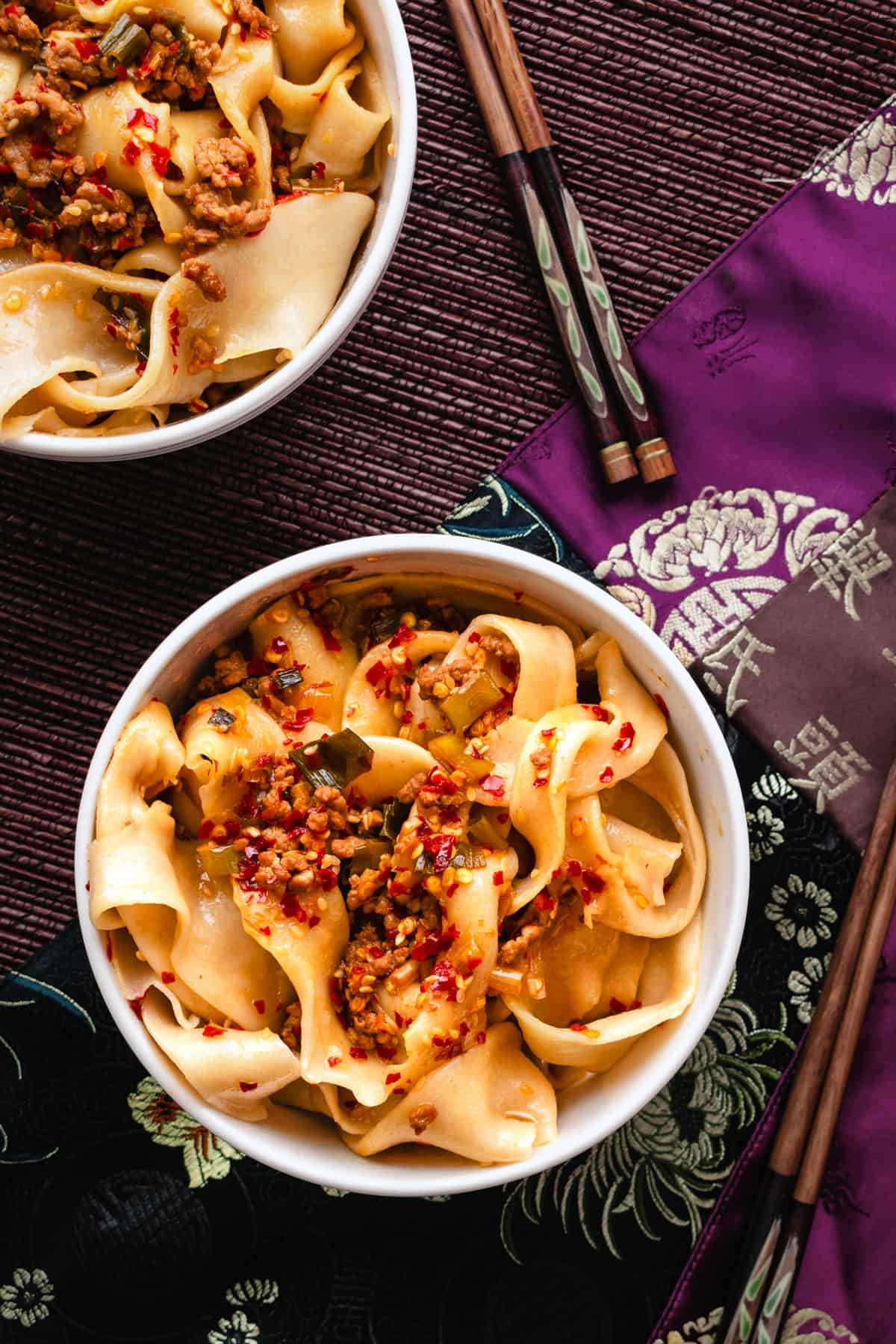
What are Biang Biang Noodles?
Also known as biangbiang noodles or youpo chemian, biang biang noodles is a noodle dish originating from the Shaanxi Province of Northwestern China. Shaanxi cuisine uses noodles more than other regions of China and it’s known for it’s particularly thick and long noodles, often described as waist belts. In fact, these stand-out noodles are known as one of the “eight curiosities of Shaanxi”, the other curiosities including things like their famous giant pancakes (giant as in the size of a manhole!), decorated head kerchiefs worn by the women, the custom of Shaanxi women to never marry anyone outside of their immediate town, the preference of squatting over sitting (even choosing to squat on top of a chair or bench instead of sitting on it) and Qin opera (one of the oldest forms of Chinese opera characterized by more of a loud yelling than actual singing). From what I understand, the Shaanxi people are keenly are aware of these cultural curiosities and proudly lean into them.
Biang Biang Noodles are prepared with or without minced meat, a combination of vinegar, oil, chilies, green onions, garlic and spices. Achieving their intended purpose, they are cheap to make and deliciously filling.
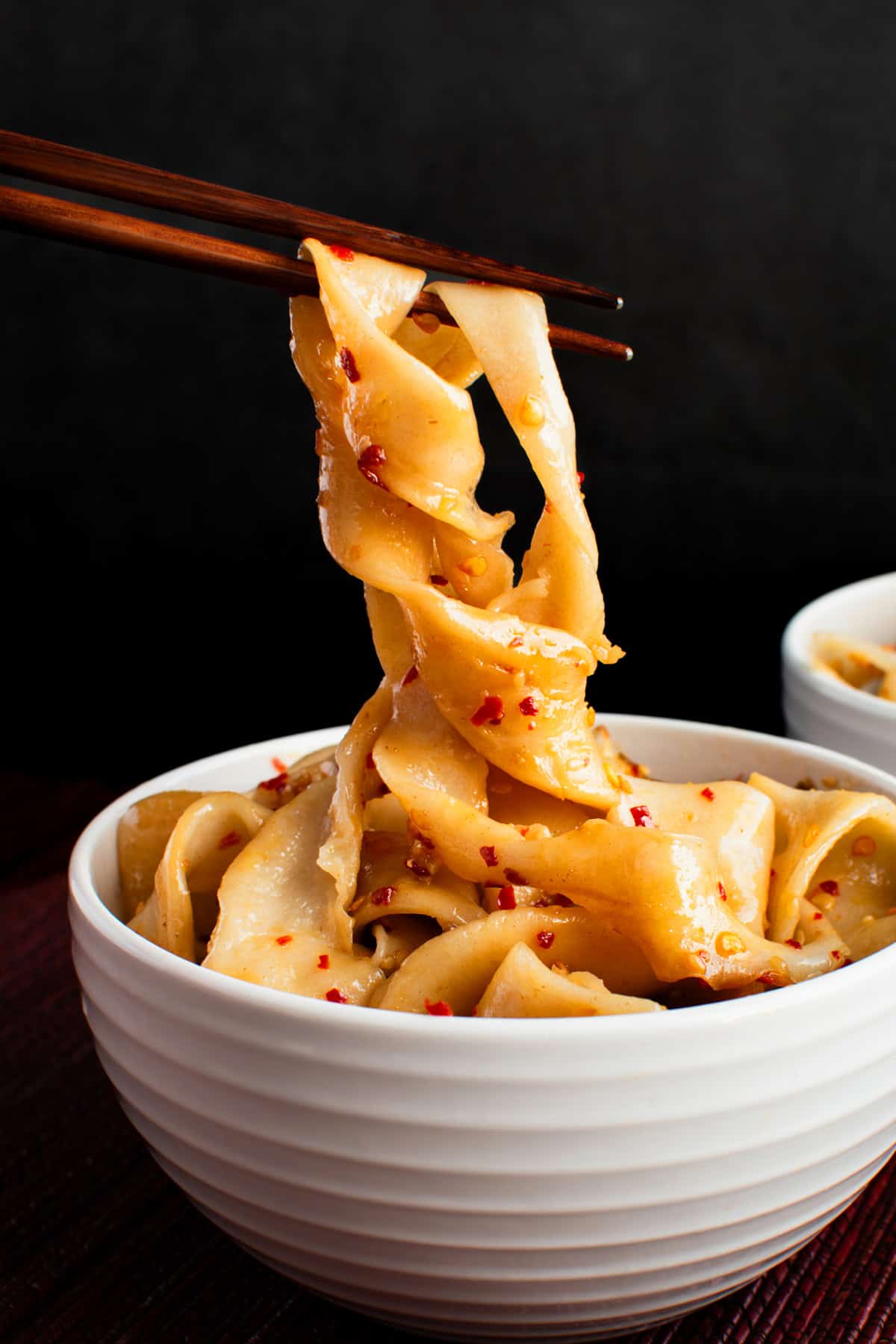
An interesting aspect of these noodles is how the word is written in Chinese. The Chinese written character used to represent the word biang is apparently one of the most complex of all Chinese characters and it isn’t even found in modern dictionaries. The character is comprised of a full 58 strokes! (Check out this gif that illustrates the process of writing this character.) I don’t know about you, but by the time I was done sketching out that Chinese character, I’d feel pretty darn well deserving of a big serving of biang biang noodles!

Biang Biang Noodles Ingredients
This is a simple dish with the noodles being the primary star of the show. If you have a well-stocked spice cabinet, the ingredients are all likely ones that you already have in your pantry. Here’s what you’ll need to make biang biang noodles:
- Flour: You can use either all-purpose flour or bread flour (bread flour will give you even chewier results). You’ll combine the flour with water and salt to make the noodles.
- Ground Pork: I’m using pork but Shaanxi cuisine also commonly uses duck, lamb, beef and chicken (ground or finely chopped). Biang Biang noodles are also commonly made without meat (which you can omit if you prefer), but I really like the added flavor and texture.
- Peanut Oil: For cooking the pork, garlic and ginger before adding the remaining sauce ingredients. You can substitute any neutral-flavored cooking oil of your choice.
- Chili Oil: A staple in Shaanxi cuisine. As with all sauces and condiments, nothing compares to homemade and I highly encourage you to use to make homemade Chili Oil (click the link for my recipe).
- Tamari: I prefer the flavor complexity of tamari but you can substitute light/low sodium soy sauce instead.
- Rice Vinegar: For a bit of tang and flavor balance. You can also use Chinese black vinegar.
- Sesame Oil: I use toasted sesame oil for more flavor.
- Sesame Seeds: For more flavor and some texture.
- Cumin: A key spice in Shaanxi cuisine.
- Green Onions: This adds both flavor and color.
- Garlic: That essential dose of savory umami.
- Ginger: For a hint of sweetness and a pungent, citrusy flavor.
- Sugar: Just a touch for balance.
- Optional Add Ins: You can add some extra bulk if you like by adding some vegetables. Bok choy is a common addition but you can also use spinach, kale or collard greens. If using these, add them to the boiling water along with the noodles and then drain them together.
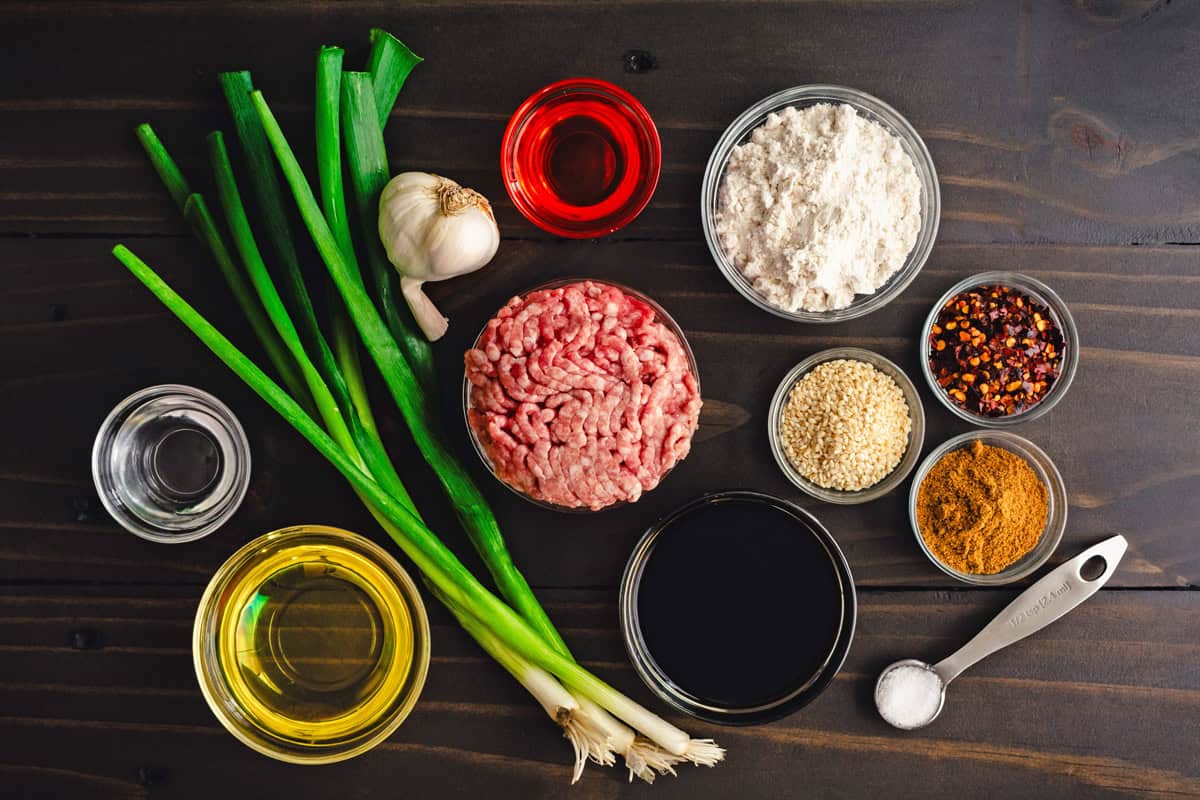
Biang Biang Noodles Recipe
Let’s get started!
The first step is to prepare the noodles. You can use store-bought if you prefer, but these biang biang noodles are so easy to prepare (no gadgets or pasta presses necessary) and taste SO much better than anything from the store, it’s well worth the extra effort. Not to mention it’s cheaper to make your own – simply the cost of some flour.
The noodles are made using a hand-pulling process and as such each noodle turns out a little different and irregular, which adds to their charm. The texture is springy and delightfully chewy.
To Make the Noodles:
Place the flour, salt and water in the bowl of a stand mixer. Stir the mixture until it comes together in a shaggy dough. Attach the dough hook and knead the dough on “2” for 15-20 minutes. The dough should be smooth and elastic and not cling to the sides of the bowl. The dough is done when you can rip off a piece of it and stretch it a good couple of inches without it tearing. If it does tear, continue to knead it for a few more minutes then test again. If needed add another tablespoon of water. If the dough is sticky, add a little more flour and knead for another 3 minutes.
Form the dough into a smooth ball and divide it into 8 roughly equal pieces. Lightly oil your hands and roll each piece into an oval, about 2 inches in length. Set them on a plate, cover with plastic wrap, and let them rest at room temperature for 3 hours. This is essential for allowing the gluten to relax so that you’ll be able to stretch the noodles.
Note: The dough can be prepared in advance and refrigerated for up to 24 hours. In fact, it will give the dough even more time to relax. Shape them into the logs, cover and refrigerate. When you’re ready to make the noodles take the dough out of the fridge and let it sit at room temperature for at least 30 minutes to soften up.
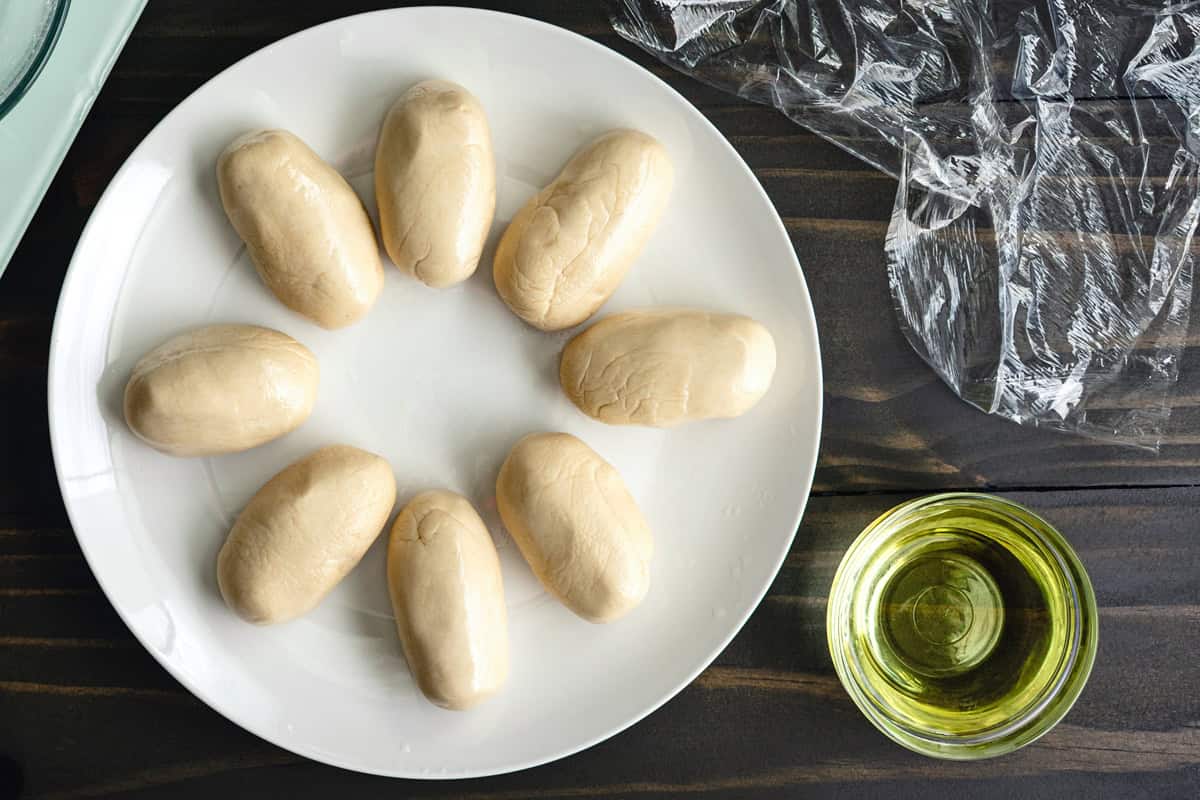
Now it’s time to stretch the noodles and stretch the noodles. Lightly oil your hands and a rolling pin and press down on each dough log to flatten it. Then take the dough in your fingertips and gently start stretching it from the center outwards, holding it by by both ends and slapping it against the counter (any guesses how “biang biang” got its name?). Aim for a width of about an inch (or wider if you prefer) and a length of roughly 10 inches. It doesn’t need to be uniform or perfect and the torn edges are part of the charm. The thickness should comparable to other pasta like fettuccine or spaghetti.
Repeat this for all of the dough logs and lay each noodle out single layer on a lined and lightly oiled baking sheet. Cover them with plastic wrap to prevent them from drying out.
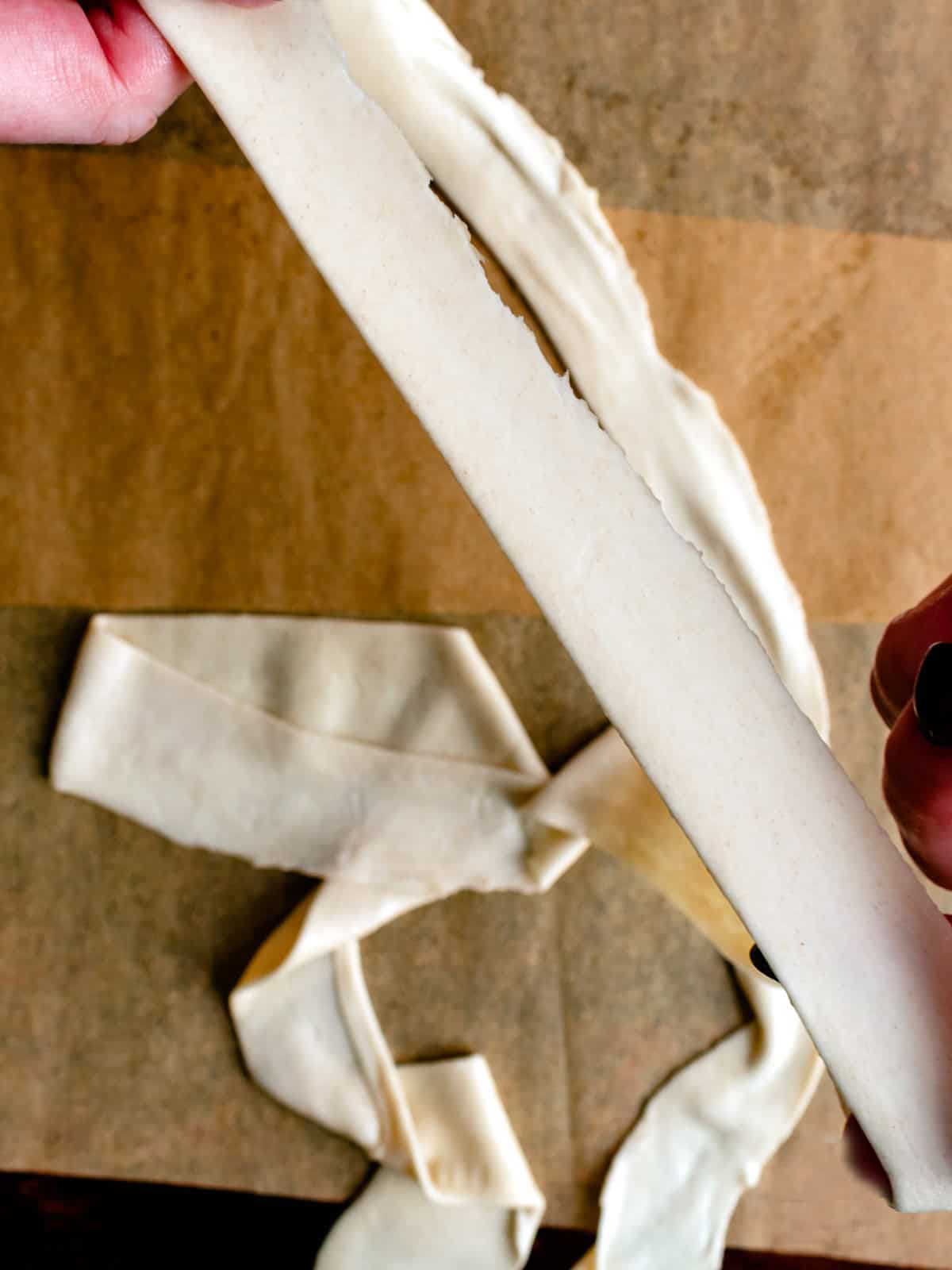
Prepare the Sauce:
The sauce can be made now or towards the end of the 3 hour resting time for the dough. To make the sauce, heat the oil in a large wok or skillet over medium high heat. Cook the ground pork until no longer pink. Add the garlic, ginger and the white parts of the green onion and cook for another minute. Add the remaining ingredients, except for the green parts of the green onions (these will be added at the end), and cook for another 2 minutes. Set aside.
Cook the Noodles:
Bring a large pot of water to a boil (start this in advance as it can take a while). Once the water is boiling gently lower the noodles into the water. Let them boil for about 1 1/2 to 2 minutes or until they fully rise to the surface. Drain them in a colander (reserving a little of pasta water in case you need to add some to the sauce) and then add the hot noodles to the sauce along with the green parts of the green onions, tossing until the noodles are fully coated. If needed add a little of the reserved pasta water. Note: If you’re adding bok choy or greens, add them to the boiling water along with the noodles and drain them together.
Enjoy!
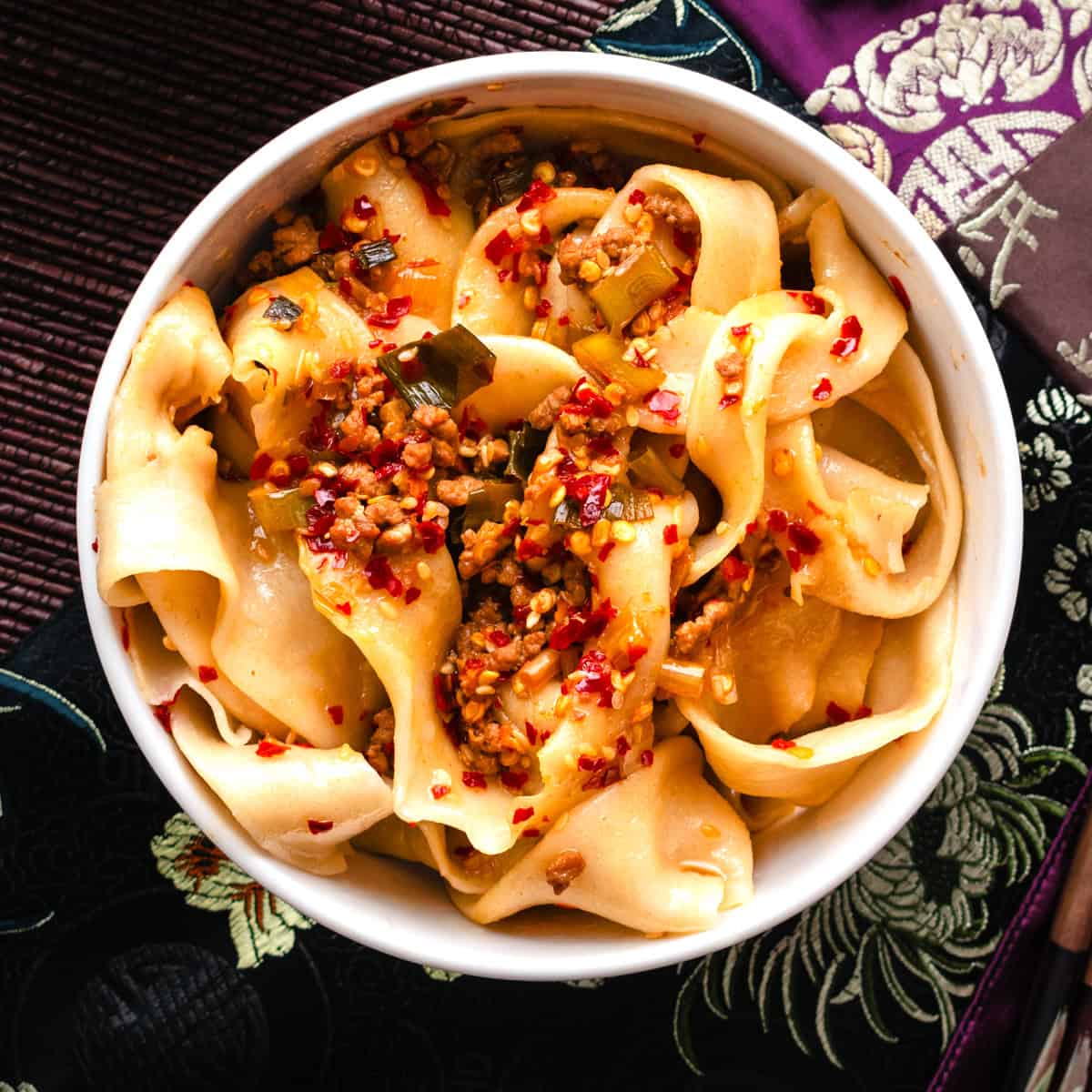
Make Ahead and Storage
To save time, the dough can be prepared a day in advance. This will give the dough even more time to relax. Once you’ve divided the dough into 8 logs and covered them with plastic wrap you can store them in the fridge. When you’re ready to make them, take them out and let them sit for at least 30 minutes to fully come to room temperature before stretching them.
Leftovers can be stored in a covered container in the fridge for up to 3 days and reheated in the microwave.
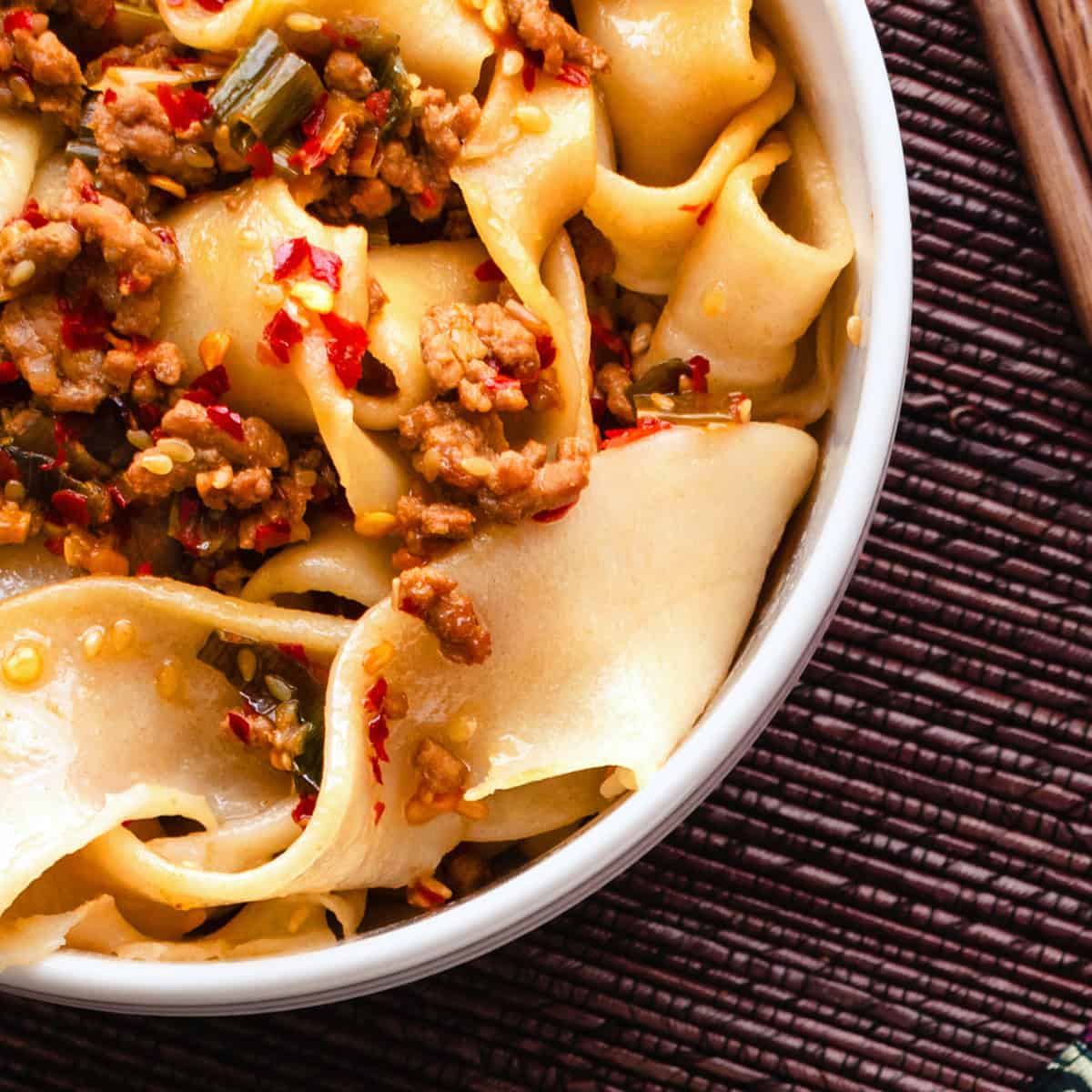
For more Chinese recipes try my:
- Chinese Beef and Broccoli
- Mongolian Chicken
- Mongolian Beef
- Egg Foo Young
- Sesame Chicken
- Kung Pao Chicken
- General Tso’s Chicken
- Orange Beef
- Orange Chicken
Save This Recipe

Biang Biang Noodles
Ingredients
- For the Noodles:
- 3 cups all-purpose flour or bread flour (bread flour will yield even chewier results)
- 3/4 cup plus 2 tablespoons water
- 1/2 teaspoon salt
- For the Sauce:
- 2 tablespoons peanut oil , or other neutral-flavored oil
- 6 ounces ground pork , or beef, lamb or chicken, cut into small pieces
- 3 cloves garlic , minced
- 1 teaspoon minced fresh ginger root
- 3 green onions , sliced and white parts separated
- 3-4 tablespoons chili oil (homemade strongly recommended, click link for recipe)
- 3 tablespoons tamari (or light soy sauce)
- 1 tablespoon rice vinegar (or Chinese black vinegar)
- 2 teaspoons toasted sesame oil
- 1 tablespoon toasted sesame seeds (toast in a dry skillet over medium heat until golden)
- 1 teaspoon sugar
- 1/2 teaspoon cumin
- 3 heads baby bok choy (optional) tough ends removed and chopped into bite-sized pieces
Instructions
- Make the Noodles: Place the flour, salt and water in the bowl of a stand mixer. Stir the mixture until it comes together in a shaggy dough. Attach the dough hook and knead the dough on "2" for 15-20 minutes. The dough should be smooth and elastic and not cling to the sides of the bowl. The dough is done when you can rip off a piece of it and stretch it a good couple of inches without it tearing. If it does tear, continue to knead it for a few more minutes then test again. If needed add another tablespoon of water. If the dough is sticky, add a little more flour and knead for another 3 minutes.Form the dough into a smooth ball and divide it into 8 roughly equal pieces. Lightly oil your hands and roll each piece into an oval, about 2 inches in length. Set them on a plate, cover with plastic wrap, and let them rest at room temperature for 3 hours. This is essential for allowing the gluten to relax so that you'll be able to stretch the noodles.Note: The dough can be prepared in advance and refrigerated for up to 24 hours. In fact, it will give the dough even more time to relax. Shape them into the logs, cover and refrigerate. When you're ready to make the noodles take the dough out of the fridge and let it sit at room temperature for at least 30 minutes to soften up.Now it's time to stretch the noodles and stretch the noodles. Lightly oil your hands and a rolling pin and press down on each dough log to flatten it. Then take the dough in your fingertips and gently start stretching it from the center outwards, holding it by by both ends and slapping it against the counter (any guesses how "biang biang" got its name?). Aim for a width of about an inch (or wider if you prefer) and a length of roughly 10 inches. It doesn't need to be uniform or perfect and the torn edges are part of the charm. The thickness should comparable to other pasta like fettuccine or spaghetti.Repeat this for all of the dough logs and lay each noodle out single layer on a lined and lightly oiled baking sheet. Cover them with plastic wrap to prevent them from drying out.
- Make the Sauce: The sauce can be made now or towards the end of the 3 hour resting time for the dough. To make the sauce, heat the oil in a large wok or skillet over medium high heat. Cook the ground pork until no longer pink. Add the garlic, ginger and the white parts of the green onion and cook for another minute. Add the remaining ingredients, except for the green parts of the green onions (these will be added at the end), and cook for another 2 minutes. Set aside.
- Cook the Noodles: Bring a large pot of water to a boil (start this in advance as it can take a while). Once the water is boiling gently lower the noodles into the water. Let them boil for about 1 1/2 to 2 minutes or until they fully rise to the surface. Drain them in a colander (reserving a little of pasta water in case you need to add some to the sauce) and then add the hot noodles to the sauce along with the green parts of the green onions, tossing until the noodles are fully coated. If needed add a little of the reserved pasta water. Note: If you're adding bok choy, add it to the boiling water along with the noodles and drain them together.Makes 2 large servings.



















Gawd that looks good, gathering up the ingredients to make it next week!